MOORE,
Nicholas Ruxton, 1756-1816
-----------------------
 MOORE, Nicholas Ruxton, a Representative from Maryland; born near Baltimore MOORE, Nicholas Ruxton, a Representative from Maryland; born near Baltimore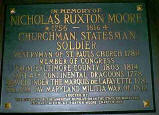 Town, Baltimore County, Md., July 21, 1756; attended the common schools;
member of Gist’s Baltimore Independent Cadets and served throughout the
greater part of the Revolutionary War, attaining the rank of captain; took
an active part in the suppression of the Whisky Insurrection in 1794; member
of the State house of delegates in 1801 and 1802; elected as a Republican to
the Eighth and to the three succeeding Congresses (March 4, 1803-March 3,
1811); chairman, Committee on Accounts (Tenth and Eleventh Congresses);
unsuccessful candidate for reelection to the Twelfth Congress; appointed
lieutenant colonel commandant of the sixth regimental cavalry district of
Maryland on February 20, 1812; elected to the Thirteenth and Fourteenth
Congresses and served from March 4, 1813, until his resignation in 1815
before the convening of the Fourteenth Congress; chairman, Committee on
Accounts (Thirteenth Congress); died in Baltimore, Md., October 7, 1816;
interment in a private cemetery near Ruxton, Baltimore County, Md.
Town, Baltimore County, Md., July 21, 1756; attended the common schools;
member of Gist’s Baltimore Independent Cadets and served throughout the
greater part of the Revolutionary War, attaining the rank of captain; took
an active part in the suppression of the Whisky Insurrection in 1794; member
of the State house of delegates in 1801 and 1802; elected as a Republican to
the Eighth and to the three succeeding Congresses (March 4, 1803-March 3,
1811); chairman, Committee on Accounts (Tenth and Eleventh Congresses);
unsuccessful candidate for reelection to the Twelfth Congress; appointed
lieutenant colonel commandant of the sixth regimental cavalry district of
Maryland on February 20, 1812; elected to the Thirteenth and Fourteenth
Congresses and served from March 4, 1813, until his resignation in 1815
before the convening of the Fourteenth Congress; chairman, Committee on
Accounts (Thirteenth Congress); died in Baltimore, Md., October 7, 1816;
interment in a private cemetery near Ruxton, Baltimore County, Md.
Last Will and Testament of Nicholas Ruxton
Moore of Baltimore county Dated 10 April 1815 & Proved 6 Nov 1816
In the name of God, Amen. I, Nicholas Ruxton Moore of Baltimore County and
State of Maryland, Sensible of the uncertainty of the time when I shall be
called to another world and warned by my Present feelings to guard against
any difficulties that might arise from having some where in existence two
wills made many years ago, do make and ordain this my last will and
Testament, hereby revoking all former wills. It is my will that after the
payment of all just and fair debts and complying with the true intent and
meaning of any obligation or Instrument of writing that I have given that
the whole of my estate real and personal (except the broad sword I wore in
the revolution) be distributed and divided to my much loved wife, Sarah, and
my dear Children Rebecca, Gay, Camilla, and Smith Hollins Moore, as the laws
of Maryland direct in cases of persons dying intestate. I constitute my
wife, Sarah, together with Cumberland Dugan, Esq., John Hollins, Esq.,
Executors of this my last will and Testament revoking all others and
publishing and declaring this to be my last will made this tenth day of
April eighteen hundred and fifteen.
Nichs R Moore (seal)
Codicil - I give sword (sic) to my son Smith H. Moore to be used when the
service of his Country demands it.
Signed, Sealed, published and declared in presence of us the subscribers and
in presence of each other.
Thomas Johnson
John Coakey, Junr.
Elijah Fishbaugh his X mark
Old St. Paul's: A brief
history and tour
Click a picture to see it
larger then press the back button on your browser to return to this page.

Old St. Paul's began as one of the original
thirty parishes established in Maryland by the Church of England in 1692 and
predates the founding of Baltimore City itself in 1729. The first church,
shown above, was a log cabin structure on the banks of Colgate Creek near
present-day Dundalk in southeast Baltimore County. By the 1720s it became
clear that the major population center of the colony would be further north
and west, so the Maryland Assembly was called upon to lay out what they
termed 'Baltimore Town.' At this time the parish vestry purchased a lot for
a new church building in the newly-formed village. This site was a choice
piece of property encompassing the highest point overlooking the harbor. The
current church occupies the northwestern-most corner of this original
parcel. So it was that the second church building of St. Paul's Parish was
constructed in the 1730s.
In 1791 funds were secured to build a suitable
rectory to house the parson and his family. The Historic Rectory now sits
one block west of Old St. Paul's on the corner of Saratoga and Cathedral
Streets and, though it no longer houses the rector's family, is the oldest
continuously occupied house in the City of Baltimore. It also houses the
offices of Preservation Maryland.
The
parish cemetery was moved in 1800 to what was then the western edge of
the city, now the corner of Redwood Street and Martin Luther King, Jr.
Boulevard, behind the University of Maryland Hospital. Among the many
notable Marylanders buried there is Samuel Chase, a signer of the
Declaration of Independence and General George Armistead, commander of the
garrison at Fort McHenry during the War of 1812. The cemetery is open to the
public by appointment through the parish office.
 The
third building to be called St. Paul's Parish, shown on the left, was
erected in 1817, and designed by the noted Baltimore architect Robert Cary
Long (1770-1833) who is buried in
St. Paul's
cemetery. As the city continued to grow into an urban center it became
clear that a rustic church building with a courtyard seemed out of place.
The new building with its 126-foot tower, was neoclassical in style and
offered an imposing façade of Doric, Ionic, and Corinthian columns abutting
Charles Street. One Scotsman who visited the church noted its "splendid
interior," the rows of Corinthian columns and a "great deal of gilding and
decoration." This massive, 1,600-seat structure served the parish well until
it tragically burned nearly to the ground in 1854, but its foundation and
surviving brick walls were retained and used in the present church building. The
third building to be called St. Paul's Parish, shown on the left, was
erected in 1817, and designed by the noted Baltimore architect Robert Cary
Long (1770-1833) who is buried in
St. Paul's
cemetery. As the city continued to grow into an urban center it became
clear that a rustic church building with a courtyard seemed out of place.
The new building with its 126-foot tower, was neoclassical in style and
offered an imposing façade of Doric, Ionic, and Corinthian columns abutting
Charles Street. One Scotsman who visited the church noted its "splendid
interior," the rows of Corinthian columns and a "great deal of gilding and
decoration." This massive, 1,600-seat structure served the parish well until
it tragically burned nearly to the ground in 1854, but its foundation and
surviving brick walls were retained and used in the present church building.
The vestry wasted little time securing the
funds and design for a new church structure for what would become the fifth
and current building of St. Paul's Parish. The new building was designed by
the famous English-born architect, Richard Upjohn. Upjohn created an
impressive Italian Romanesque building that was consecrated in 1856.
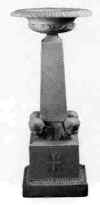
A few things survived the fire of 1854 and
exist today in the present church. One item is the old baptismal font
(located now near the Lady Chapel and shown on the left), designed by French
architect Maximilian Godefroy; the marble piece was carved in Livorno, Italy
and shipped to Baltimore. Another item is the Bishop's Chair, shown on the
right, with its gilded croziers and miter, a gift to the parish from
vestryman George Grundy, who lived at the Bolton mansion on the site of the
Fifth Regiment Armory. Additionally, part of the window,
Suffering Christ, survived the fire.
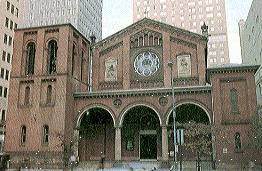 The
current St. Paul's church building is also blessed with an exceptionally
beautiful interior. The chancel was redecorated and beautified in 1902 in a
most elegant style. One of the principal changes was the addition of the
Great East Window which replaced the much smaller window containing the
figure of
St. Paul. The
current St. Paul's church building is also blessed with an exceptionally
beautiful interior. The chancel was redecorated and beautified in 1902 in a
most elegant style. One of the principal changes was the addition of the
Great East Window which replaced the much smaller window containing the
figure of
St. Paul. This large stained-glass window, the work of Helen Maitland Armstrong,
depicts the Glorification of God, inspired by the "Benedicite, omnia opera
Domini" ("O ye Spirits and Souls of the Righteous, bless ye the Lord; praise
him and magnify him for ever"). The window was refurbished in 1994. The dark
red walls, marked with religious symbols, also date from the 1902
restoration. There soon followed a number of lovely stained glass windows in
the nave by Tiffany and Company, and by Clayton & Bell, a famous English
studio.
This large stained-glass window, the work of Helen Maitland Armstrong,
depicts the Glorification of God, inspired by the "Benedicite, omnia opera
Domini" ("O ye Spirits and Souls of the Righteous, bless ye the Lord; praise
him and magnify him for ever"). The window was refurbished in 1994. The dark
red walls, marked with religious symbols, also date from the 1902
restoration. There soon followed a number of lovely stained glass windows in
the nave by Tiffany and Company, and by Clayton & Bell, a famous English
studio.
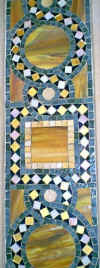  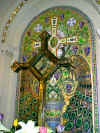 In 1904, the exquisite Louis Comfort Tiffany reredos was installed. This
mosaic reredos has Caen stone panels containing Christian symbols, including
the peacock. The cross in the center panel contains peridot,
In 1904, the exquisite Louis Comfort Tiffany reredos was installed. This
mosaic reredos has Caen stone panels containing Christian symbols, including
the peacock. The cross in the center panel contains peridot,
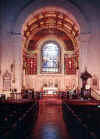 the August birthstone. the August birthstone.
In 1990-91, the chancel, including the reredos,
was wonderfully restored to its
original glory.
Some pictures of Old St.
Paul's historic cemetery
*To LIEUTENANTS WILLIAM BIRD, RICHARD
DORSEY,
JOHN CRAIG, NICHOLAS RUXTON MOORE, AND GEORGE GRAY
of Colo Moylan's Light Dragoons
Camp at the Cross Roads,
August 17, 1777.
Gentlemen:
I have just received your Letter of this date with the inclosed Certificates
justifying your pretentions to the Rank you mention.
I must repeat to you, that I am entirely ignorant of the means by which such
an idea was propagated; nor did I ever see any Reason why superior Rank
should be given to Officers of Cavalry but where
Commissions are equal, the Commands should be ascertained by priority of
date.
I shall never wish to influence any Gentlemen to save in this Army, if I
have Reason to believe they cannot do it consistent with that strict notion
of Honour, which should be the invariable rule of conduct for every Officer,
but am of opinion, nevertheless, that a Resignation in this part of a
Campaign can only be warranted by treatment, which would be disgraceful to
bear, and therefore that your Resolution not to resign, at least, till the
end of the Campaign must meet the approbation of all who wish to see you act
with propriety.
I am etc. 8
*To LIEUTENANTS WILLIAM BIRD, RICHARD
DORSEY,
JOHN CRAIG, NICHOLAS RUXTON MOORE, AND GEORGE GRAY
of Colo Moylan's Light Dragoons
Camp at the Cross Roads, August 15, 1777.
Gentlemen:
In answer to your respective Letters without date, but
presented to me Yesterday, you will please to be inform'd.
First, that the pay of the Horse Offices was fixed in
December last, and at the same rates now existing, and,
Secondly, that I am not conscious af ever having said,
or done any thing, that cou'd lead to a belief,
that the Rank of a Lieutt. of Horse was to be equal to
a Captain of foot, for the obvious reasons,
that neither justice, or usage, would authorize it.
How it came to pass then, that you should conceive yourselves
entitled to the Rank and pay of such Officer is neither my
business, nor Inclination to enquire into;
this however, I shall add.
That if your respective application's to resign, is the
effect of hasty resolutions, you may take till tomorrow
to reconsider and recall your Letters.
But if on the other hand, you shd. then be in the same Mind,
I shall be ready to receive your Commissions if they have
been deliver'd, or give dismissions if they have not.
Your Wishes to resign at such a period as this
(after time is allowed for reconsideration)
will be sufficient evidence with me, that it is a
disinclination to the Service, and not the mere
disappointment of Rank and Pay, and therefore,
it may be unnecessary for me to add,
that any future application from either of you
to get into the Continental Service will be improper,
and, as far as it is in my power to make it so, unavailing.
I am etc. 8
Nicholas Ruxton Moore. Born on 21 Jul 1756 in Baltimore Co., MD.
Nicholas Ruxton died in Baltimore, MD on 7 Oct 1816, he was 60.
On 21 Jul 1779 when Nicholas Ruxton was 23, he first married
Elizabeth Orrick, in Maryland. Born on 1 Apr 1758 in Anne Arundel
Co., MD. Elizabeth died in Maryland on 28 Nov 1784, she was 26.
On 25 Dec 1793 when Nicholas Ruxton was 37, he second married Sarah
Kelso, in Baltimore Co., MD. They had the following children: i. Rebecca. Born on
23 Oct 1794; ii. Gay. Born on 16 May 1801.
Served as 2nd Lieutenant of Fulford's
Company Maryland Cannoneers, March 1776; Lieutenant 4th Continental
Dragoons, 2 Feb 1777; Captain, 15 Mar 1778; resign d 31 Dec 1778;
Captain Maryland Cavalry Militia in 1781 ("Historical Register of
Officers of the Continental Army During the War of the Revolution,"
Franci B. Heitman, Rev. ed. Washington, D.C.: The Rare Book Shop
Pub. Co., 1914, p 399). There are two letters from Nicholas Ruxton
Moore preserved among George Washington's papers at the Library of
Congress. The first is dated 14 Aug 1777: "May it please your
Excellency: When I entered into Col. Moylan's Reg' of Horse I was
led to believe by his promise (which he says your Excellency
authorised him to make) that I should have the rank and pay of a
Captain of Fot, nor did I hear anything to the contrary untill (sic)
some time after I had joined the Reg't, when I found that I have
neither. I then appealed (?) to Col. Moylan for redress but could
not obtain it. It is with the greatest reluctance that I think of
leaving the service, but to think of serving in a station inferior
to what I formerly might have held, your Excellency will easily
conceive I cannot with honor do. I must therefore beg your
Excellency's permission to resign and am forever your Excellency's
most obt. hbl. svt., N. Ruxton Moore."
The second letter is dated Baltimore,
20 Dec 1778: "Sir, It is with the greatest reluctance I must address
your Excellency on a subject which to me is exceedingly
disagreeable, that of quitting the Army. Two years have now elapsed
since I had the honor of serving in the Army during which time,
having o person to take care of my business, I find it in such a
poor and confused situation that was I to gratify my inclination by
serving only one campaign more, it would be making a sacrifice of
allmost (sic) everything I have in the would. Your Excellency will
readily conceive my uneasiness on this occasion when I do
assure you upon my honor it is with the greatest regret that I shall
leave the service. My commission as Captain of MD I should have
inclosed but I ave not received it -- as a state of suspense is most
disagreeable. I must beg the favor of your Excellency to forward
your permission for my resignation as conveniently possible -- while
I remain your Excellency's most obt. hbl. set. -- Nich. Ruxton
Moore."
Washington's response was written by
James McHenry and dated Headquarters, Middlebrook, 27 Mar 1779:
"Dear Sir, Your letter to his Excellency of the 20th December came
to hand the 25th instant. The General desires to express his
unwillingness to loose (sic) an officer who has given proof of zeal
and ability during the time of his service. But as you have taken
the resolution to leave the army, his Excellency cannot withhold his
permission. It will be necessary, however, that you should transmit
a certificate of your having no accounts unsettled in the Regiment
or with the public previous to its acceptance. I wish you much honor
and reputation in your new pursuit -- and am, Dear Sir, Yours very
sincerely, James McHenry."
Edward E. Steine published an article
titled "Nicholas Ruxton Moore: Soldier, Farmer and Politician," in
the Maryland Historical Magazine, no. 73 (December 1978), pp. 375
388. MOORE, Nicholas Ruxton, 1756-1816
MOORE, Nicholas Ruxton, a Representative from Mary and; born near
Baltimore Town, Baltimore County, Md., July 21, 1756; attended the
common schools; member of GistRs Baltimore Independent Cadets and
served throughout the greater part of the Revolutionary War,
attaining the rank of captain; took an active part in the
suppression of the Whisky Insurrection in 1894; member of the State
house of delegates in 1801 and 1802; elected as a Republican to the
Eighth and to the three succeeding.
Nicholas Ruxton Moore (1756-1816) Born
in Baltimore County, Md., July 21, 1756. Democrat. Served in the
Continental Army during the Revolutionary War; Presidential Elector
for Maryland, 1800; member of Maryland state house of delegates,
1801-02; U.S. Representative from Maryland, 1803-11, 1813-15
(at-large 1803-07, 5th District 1807-11, 1813-15). Episcopalian.
Died in Baltimore, Md., October 7, 1816. Interment at at a private
or family graveyard.
 History
of the Area Ruxton was first settled in 1699 when Thomas Hooker
built a home on a 500 acre tract granted to him five years earlier.
A dwelling on the property, sometimes called Carr's Pleasure, stands
today on the eastern side of Bellona Avenue near the center of the
community. The area remained sparsely settled for nearly two
centuries. In the 1880s the building of a railroad created a link to
the city of Baltimore. The year round and summer population grew. By
then, the community had a name--Ruxton--after Nicholas Ruxton Moore,
a Revolutionary War officer and former resident. History
of the Area Ruxton was first settled in 1699 when Thomas Hooker
built a home on a 500 acre tract granted to him five years earlier.
A dwelling on the property, sometimes called Carr's Pleasure, stands
today on the eastern side of Bellona Avenue near the center of the
community. The area remained sparsely settled for nearly two
centuries. In the 1880s the building of a railroad created a link to
the city of Baltimore. The year round and summer population grew. By
then, the community had a name--Ruxton--after Nicholas Ruxton Moore,
a Revolutionary War officer and former resident.
376 MARYLAND RECORDS— KILTY'S Lx'WVS
Moore, for the repair of arms and equipment of the
accoutrements of his company, and to make such allowance
as they may consider him entitled to."
More, Nicholas Ruxton, Gentleman. Com'd. 3"^ Lieut, of a
Company of Matrosses to be raised in this Province for
the defence of the Liberties thereof Commanded by Capt.
John Fulford. Given in Council of Safety at Baltimore
Town, Mch. i, 1776. Daniel of St. Thos. Jenifer, Charles
Carroll, Benjamin Rumsey, Th. B. Hands, Thos. Smyth. (X,
No. 133).
Moore, Lieut. Nicholas R. Passed
Mch. 4, 1834 — No. 36. Treas. Western Shore pay to Sarah
Moore (widow of Nicholas R. Moore), of Baltimore county,
during life, quarterly, half pay of a Lieut., for the
services rendered by her husband during the rev. war.
Moore, Capt. Nicholas R. Passed Feb. 7, 1840 — No. 6.
Treas. Western Shore pay to Sarah Moore, widow of
Nicholas R. Moore, of Baltimore city, during life,
quarterly, commencing Jan. i, 1840, a sum equal to the
half pay of a captain of cavalry, in lieu of half pay of
a lieut, heretofore granted,
in consideration of the services rendered by the husband
during the rev. war.
|

